
MP S.M. Marikkar has announced that the tariff for solar power will be reduced to Rs. 16 per unit, attributing the decrease to adjustments in foreign exchange rates and electricity pricing. Speaking at a media conference at the Samagi Jana Balawegaya (SJB) party office, he criticized the government’s handling of the energy sector and recent nationwide power outages.
Marikkar mocked the government’s explanation for the power failure on Sunday, where the Minister of Power blamed a monkey for jumping into the Panadura grid. He pointed out that even in 1988-89, when 33,000-megawatt transformers were burned and LTTE terrorists carried out attacks, the national grid did not collapse, yet a single incident now disrupts the entire system. He accused the government of constantly shifting blame, first pointing fingers at an animal and later at the previous administration instead of taking responsibility and fixing the issue.
He also highlighted contradictions in Minister Sunil Handunnetthi’s statements, recalling that Handunnetthi had previously claimed that power outages were caused by an energy mafia. Marikkar suggested that the government’s narrative has changed depending on the situation, raising further questions about accountability.
The Ceylon Electricity Board (CEB) has reported that solar power generation in Sri Lanka has exceeded expectations. While the target was to generate 1,000 megawatts from one million households over a decade, current production has already reached 1,200 megawatts. Marikkar explained that the government is now reducing payments for solar power units to manage energy costs.
He noted that when the dollar was at 180, the cost of solar power was Rs. 22 per unit. When the dollar surged to 350, it increased to Rs. 37 per unit. As the dollar dropped below 300, the tariff was reduced to Rs. 27 per unit, and now it is being further lowered to Rs. 16 per unit.
The reduction aims to align energy costs with the strengthening rupee and control electricity expenses, though concerns remain over whether this will discourage further investment in solar energy. With Sri Lanka’s energy crisis and power grid stability under scrutiny, the government’s next steps in managing renewable energy pricing will be closely watched.




